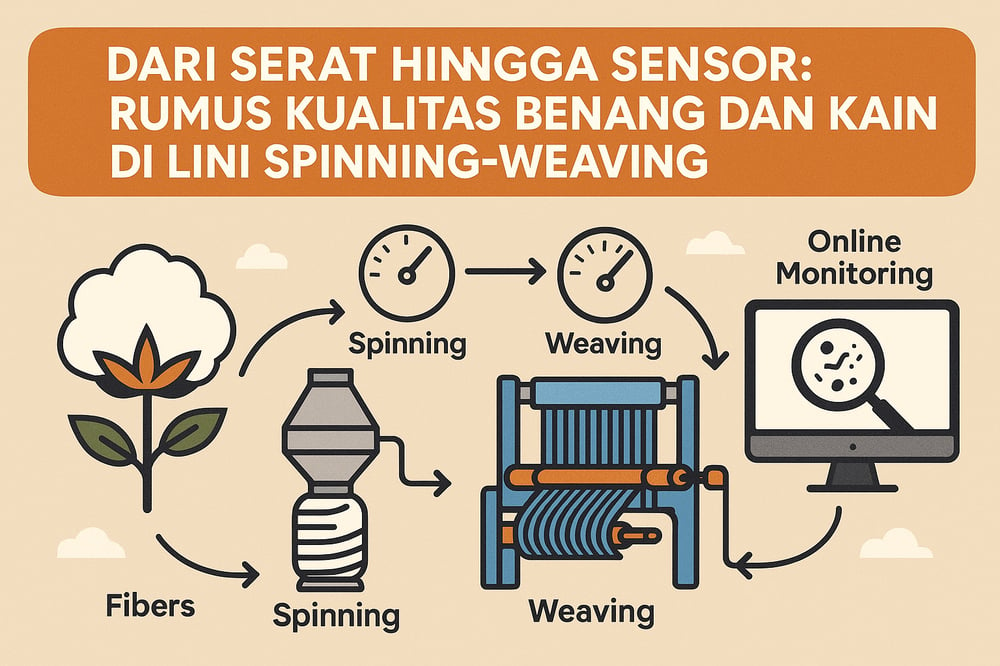In spinning and weaving, quality is not an accident. It’s a function of fiber properties, frame parameters, and warp tension—measured, tuned, and increasingly checked by cameras and optics in real time.
Industry: Textile | Process: Fiber_Spinning_&_Weaving
Start with the fiber. Raw cotton alone can account for roughly 50% of short‑staple yarn production cost, a reminder that selection and control at the bale gate can cap or unlock downstream quality (slideshare.net). End with the fabric. On the loom, small shifts in warp tension ripple into strength loss, width distortion, or dye‑shade variation (researchgate.net).
In between, modern lines are leaning on sensors. Yarn clearers, optical heads sampling at 2 MHz, and deep‑learning fabric cameras now catch >95% of anomalies before they metastasize into rework or scrap (pmc.ncbi.nlm.nih.gov; mdpi.com; mdpi.com).
Fiber property control and blending
Fiber characteristics set a fundamental limit on yarn quality. Longer staple length and higher length uniformity generally yield stronger, more even yarns with fewer faults (researchgate.net). Conversely, a high short‑fiber content or immature fibers raise imperfections: fiber length distribution strongly predicts yarn strength and irregularities, and high short‑fiber percentages increase neps (small fiber knots), thin/thick places, and hairiness (researchgate.net).
Controlled trials underscore the leverage in selection and blends. Using longer staple blends—such as combining Greek cotton with recovered fibers—improved homogeneity and reduced thick places in rotor‑spun yarn by up to 74% (yarnmanufacturing.blogspot.com). Even a 25% addition of waste fiber, if well‑controlled, did not degrade yarn uniformity or appearance (yarnmanufacturing.blogspot.com).
Fineness (fiber linear density) enables finer yarn counts but can reduce individual fiber strength; maturity influences dye uptake and strength. Moisture matters as well: maintaining “micro‑wet” conditions—around 8–12% moisture regain—reduces static and breakage during spinning and enables higher speeds (dkyarn.com).
Spinning parameters and defect rates
Machine settings then shape how fiber potential turns into yarn. Yarn count (tex, grams per 1,000 meters) directly influences defect rates: finer counts typically show fewer thick/thin faults. In rotor spinning, reducing yarn count from 20 tex to 10 tex improved homogeneity by 74%, dramatically cutting thick‑place defects (yarnmanufacturing.blogspot.com).
Opening‑roller speed is another lever: increasing it from 7,000 to 8,800 RPM reduced neps by ~43% (yarnmanufacturing.blogspot.com), while too‑high rotor speeds tended to degrade uniformity (yarnmanufacturing.blogspot.com). Rotor geometry matters: a tighter‑geometry rotor (T40/T46 vs. older U‑type) reduced hairiness by roughly 31% and improved uniformity (yarnmanufacturing.blogspot.com).
Twist factor (twists per unit length) showed a relatively minor effect on uniformity in one statistical study; its primary role is balancing strength versus softness (yarnmanufacturing.blogspot.com). Practical control still hinges on precise opener separation and drafting pressure: poor opening leaves residual fiber clumps, and incorrect drafting pressure can cause “hard ends” or ribboning, all upping irregularity. In factorial trials, a Tunisian group achieved yarn evenness and hairiness on par with virgin‑fiber yarns even using 25% recycled content (yarnmanufacturing.blogspot.com; yarnmanufacturing.blogspot.com).
Industry experience aligns: tight control of these parameters raises productivity because fewer weak spots mean fewer stoppages (fibre2fashion.com). Quality management methods are used to determine statistically meaningful values referred to “weak places” in yarn (fibre2fashion.com).
Weaving tension regulation and fabric outcomes

On the loom, consistent tension across warp ends (warp = lengthwise yarns) and steady behavior through the cycle drive fabric appearance and mechanical properties. Excessive or uneven warp tension can decrease fabric strength and create width distortion; raising warp tension reduced breaking strength in the warp direction in experiments on plain‑woven polyester, especially with thin weft (weft = crosswise yarns) (researchgate.net).
Optimally, electronic let‑off and take‑up controls maintain a set tension. Online sensors continuously adjust warp‑beam payout so that as more cloth is wound on, fabric density—picks per inch (PPI)—stays constant (onlinetextileacademy.com). Warp‑stop motions halt production immediately upon a warp break to prevent holes. Still, minor tension fluctuations through shedding and beat‑up can lead to uneven dye uptake and shading because more‑drawn yarn carries less crimp (researchgate.net).
Mills report direct waste reduction from tension control: poor settings can trigger selvedge wrinkles or “start‑up marks” on new beams. While quantitative data are limited, reviews note that automated regulation—tension‑compensating cams and dancers—dramatically reduces warp breakages and post‑loom rejections. In Indonesia and elsewhere, producers typically follow industry guidelines or ISO textile standards (if domestic regulations apply, they mirror international norms; no unique Indonesian tension spec is found) (productcomplianceinstitute.com; turcomat.org).
Online monitoring and defect detection systems
Automated sensing now polices quality in real time. In spinning, yarn clearers and optical sensors monitor thickness, neps, and filament behavior. For filament yarns, modern optical “OLO” sensors can detect broken filaments, denier variation, and twist anomalies at high speeds; a 2 MHz optical monitor can stop a winding machine on the first large defect, eliminating long imperfections. In trials, detection rates surpassed 98% for controlled defects (pmc.ncbi.nlm.nih.gov).
In weaving, machine‑vision inspection (line‑scan cameras with engineered lighting) flags holes, slubs, stains, or pattern errors. Deep‑learning systems such as YOLOv8 reported mean average precision (mAP) ≈ 84.8%, precision ≈ 0.818, and recall ≈ 0.839 across seven defect classes in recent literature (mdpi.com), with other studies quoting 95–98% accuracy in automatic identification (mdpi.com). Manual inspection is error‑prone and slow: one review found that 15–20% of woven cotton fabric is typically scrapped during human quality checks (mdpi.com).
Mills that add online camera inspection often cut rework and waste. JCT纺织 reports suggested that replacing even part of their manual men’s‑picking crop inspection with automated vision could eliminate most of that 15–20% rejection rate (mdpi.com). In practice, combining yarn and fabric monitoring yields the best results: warped yarn is checked on creels before weaving, and finished cloth is inspected immediately off‑loom, preventing defect propagation.
Data‑driven operations and standards
Across reviews and plant trials, the through‑line is clear: fiber properties (length, strength, cleanliness) and machine settings (twist, speed, tension) quantitatively determine yarn evenness, strength, and defect counts (slideshare.net; researchgate.net; yarnmanufacturing.blogspot.com; yarnmanufacturing.blogspot.com). Online sensors and vision systems routinely catch >95% of yarn/fabric anomalies (pmc.ncbi.nlm.nih.gov; mdpi.com; mdpi.com). Together, these data‑driven practices enable mills—including Indonesian exporters that abide by SNI/ISO norms (productcomplianceinstitute.com; turcomat.org)—to minimize waste, maximize throughput, and sustain consistent yarn and fabric performance.
